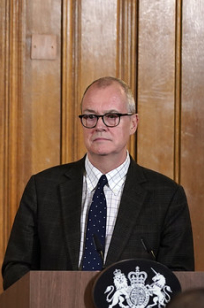Covid-19 update: 3 April
There has been an understandable focus on deaths as the ultimate way of tracking the course of the virus. At Monday’s government news conference, chief scientific adviser Sir Patrick Vallance warned people not to read too much into the two days of a reduced mortality count over last weekend. His point was suitably underlined when this was followed by three consecutive days of the highest increases so far (381, 563 and 569 reported Tuesday to Thursday).
This week also saw the Office for National Statistics publishing new provisional figures giving a broader view of deaths related to Covid-19 in England and Wales. The ONS figures differ from those published daily by the Department of Health and Social Care in both timing and scope. The Department’s figures cover deaths in UK hospitals among patients who have tested positive for coronavirus. The ONS data lags behind these figures because of the time taken to register a death. However, the ONS figures count all deaths where Covid-19 was mentioned on the death certificate including those, for example, in care homes.
Infection rates and hospital admissions should provide an earlier indication of how new social distancing measures are having an impact. With admissions typically occurring a week or two after an infection, it will take time before the impact of the further tightening of the UK lockdown is seen in the figures.
However, Sir Patrick (pictured) told the Monday conference that social distancing measures were making a difference, with hospital admissions not rising as fast as feared. He said the NHS was seeing about an additional 1,000 patients a day – describing this rise as stable. ‘That shows that it’s going up not in an increasing amount but in a constant amount, which may suggest that we’re already beginning to see some effect,’ he said. The expectation was for admissions to stay at this level – perhaps increasing slightly before hopefully stabilising and starting to go down in two to three weeks. Subsequent days’ admissions have seen a further increase.
Speaking at Tuesday’s briefing NHS England’s medical director Stephen Powis suggested the figures on infections and hospital admissions represented ‘green shoots’, but insisted it was still early days and the country must not get complacent in observing the current social distancing requirements.
He was asked later in the week if subsequent increases in daily reported deaths meant that the green shoots were disappearing. He said there was early academic evidence that the transmission rate may have fallen below one as a result of the social distancing measures – meaning people were no longer passing on the virus multiple times. And this will hopefully be seen in a reduction in future reported infection rates.
Deputy chief medical officer for England Jenny Harries has already warned that it could be six months before life in the UK returns to normal – although it is not expected that the country would be in complete lockdown for that period. However there has been little talk yet of what an exit strategy might look like.
In the meantime, the NHS is living very much in the now with concerns about supplies of personal protective equipment (PPE) continuing to be expressed. The BMA continued to warn that the health of doctors and patients was being placed at risk, despite assurances from the government that enough PPE would be delivered. These concerns have heightened with the sad announcements of the first frontline staff to die from the virus.
NHS England, Public Health England and the Academy of Medical Royal Colleges acknowledged in a letter to the service last weekend that there had been ‘some issues related to the supply of equipment’ and these were being resolved at pace. The letter also set out the scale of the logistical challenge. ‘In the past two weeks the NHS Supply Chain has delivered 170 million FFP3 masks, surgical masks and other PPE equipment to NHS trusts and 58,000 healthcare settings including GPs, pharmacies and community providers,’ it said. This did not include deliveries made by the armed forces – with deliveries in the two previous days including 43 million gloves, 23 million surgical masks and one million FFP3 masks, 14 million aprons and 182,000 gowns.
As the week started, NHS Providers’ chief executive Chris Hopson (pictured) said that distribution had been the key challenge with a switch to proactive delivery of orders being the immediate response. However, a more sustainable solution was needed in the longer term.
‘From next week, there will be a completely new, created in a fortnight, dedicated PPE supply chain for trusts, operating separately from the non-PPE supplies,’ he said. ‘That is a remarkable logistical turnaround and a great example of new partnerships – NHS, army and commercial sector – coming together successfully to tackle this national emergency.’ Changes were also expected for distribution to care homes and GP surgeries.
NHS Supply Chain subsequently announced that this dedicated PPE supply channel had been established with Clipper Logistics, starting from 1 April. This week also saw the publication of new guidance about PPE for NHS teams likely to come into contact with patients with coronavirus. The guidance is consistent with World Health Organisation recommendations and was backed by unions and royal colleges.
Testing has been the other high-profile concern this week with significant confusion over the numbers of ‘have you got it’ tests being delivered. This arose due to the difference in the apparent capacity of the NHS to deliver tests – 12,799 per day by the middle of the week – and the actual number of tests being carried. The latest Public Health England figures put this at 10,657.
Nationally the government has pointed to shortage of chemical reagents as the reason for the slower than desired increase in testing. NHS Providers’ Mr Hopson said there was also a mismatch in demand and capacity around the country, with some labs not working at full capacity while others struggled with high volume. Different testing platforms and geographical constraints meant that it was a complex problem.
Last weekend saw the start of staff testing – prior to this trusts had been told to focus completely on patients. Initially told to allocate up to 15% of testing capacity for staff, trusts were subsequently allowed to set the balance themselves. Staff testing – particularly of staff in isolation because a housemate is self-isolating – could enable non-infected staff to return to the frontline, helping to address ongoing staffing shortages.
The government responded to the growing concerns around testing with an announcement to massively increase daily testing to 100,00 by the end of the month. On Thursday Matt Hancock unveiled a five-point plan to upscale testing capacity. This would involve: increasing the number of swab tests by expanding centralised testing facilities; supplementing this with partnership with commercial entities; introducing an antibody blood test to test where people have had the virus; surveillance testing to determine the rate of infection in the population; and building a UK ‘diagnostics industry’ at scale. He subsequently clarified that the target did not rely on new antibody blood test for the general population to meet the goal – as these tests still needed to prove they were robust.
Related content
We are excited to bring you a fun packed Eastern Branch Conference in 2025 over three days.
This event is for those that will benefit from an overview of costing in the NHS or those new to costing and will cover why we cost and the processes.